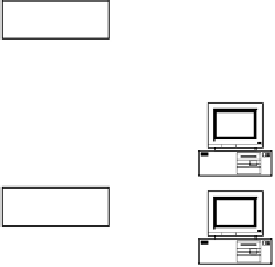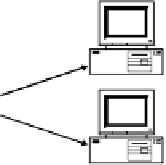Information Technology Reference
In-Depth Information
a
a
Router
b
Server load = 4 units
b
b
a
a
b
d
c
Router
c
d
c
c
Router
d
d
4 × bandwidth / link
2 × bandwidth / link
1× bandwidth / link
Figure 16.1
Sending the same content to four receivers using unicast data delivery
Nevertheless, the point-to-point delivery mechanism in unicast may impose challenges
in some applications. Take TV broadcasting as an example. Traditional TV broadcasting is
done over the air using the wireless transmission medium, which is inherently a broadcasting
medium, i.e., the signal can be received by any receivers within range. This is an important
characteristic not only from a technical point of view, but also from an economic point of view.
Specifically, in TV broadcasting the set-up cost and the operating cost are relatively constant
regardless of the number of receivers (assuming sufficient coverage) tuning to the broadcasting
channel. This allows the operator to benefit from the economy of scale such that the per-user
cost can be reduced to a sufficiently low level to make the operation economically feasible
(and profitable).
Now imagine provisioning similar video broadcasting services in the Internet. As the Internet
does not support broadcast, the service provider will need to set up media servers to stream
the contents to the individual receivers as illustrated in Figure 16.1. Suppose there are four
receivers linked up to the media server as shown in Figure 16.1, then the media server will
need to send four separate streams of data, identified by “a”, “b”, “c”, and “d” in Figure 16.1
to each of the four receivers. This is radically different from the TV broadcasting model as the
media server in this case consumes four times the bandwidth of the data rate of the content.
This means that the media server capacity, as well as the intermediate network links, will all
need multiple times the bit-rate of the media content to carry the contents to the receivers.
Obviously, this is far less efficient than broadcasting from an engineering point of view.
Moreover, the cost to the server provider will likely increase near linearly with the number of
receivers, thus lacking the economy of scale inherent in broadcasting. The alternative is to use
native network multicast [1-6].
Figure 16.2 illustrates the delivery of content to four receivers using multicast data delivery.
Compared to the unicast model in Figure 16.1, we can see that the media server and all the
intermediate network links now only need to carry one copy of the media data to the multiple
receivers. When a multicast packet reaches a router, the router will replicate and send over each





















Search WWH ::

Custom Search